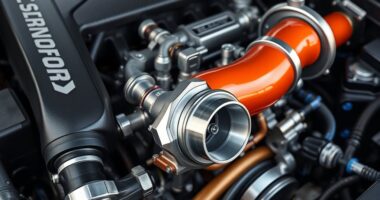If you’re looking to flash your Subaru Impreza or WRX ECU, you’ll need the right tools like a Tactrix interface and specialized software such as ECUFlash or RomRaider. This process rewrites the ECU’s firmware to boost power, improve throttle response, and customize driving feel. Compatibility varies by model and engine type, so proper preparation and safety steps are essential. Keep going to discover detailed procedures and tips to get the most from your tuning project.
Key Takeaways
- ECU flashing remaps factory software to boost performance, throttle response, and fuel efficiency on Subaru Impreza and WRX models.
- Compatibility varies by model year, engine type, and ECU architecture; pre-2005 and certain newer models may require specific tools.
- Proper hardware (like Tactrix OpenPort) and software (ECUFlash, RomRaider) are essential for safe, effective flashing.
- Vehicle preparation includes engine checks, sensor calibration, and ensuring stable power supply before flashing.
- Post-flash tuning optimizes power, boost, and drivability; troubleshooting may involve re-flashing or software updates.
Understanding the Basics of ECU Flashing
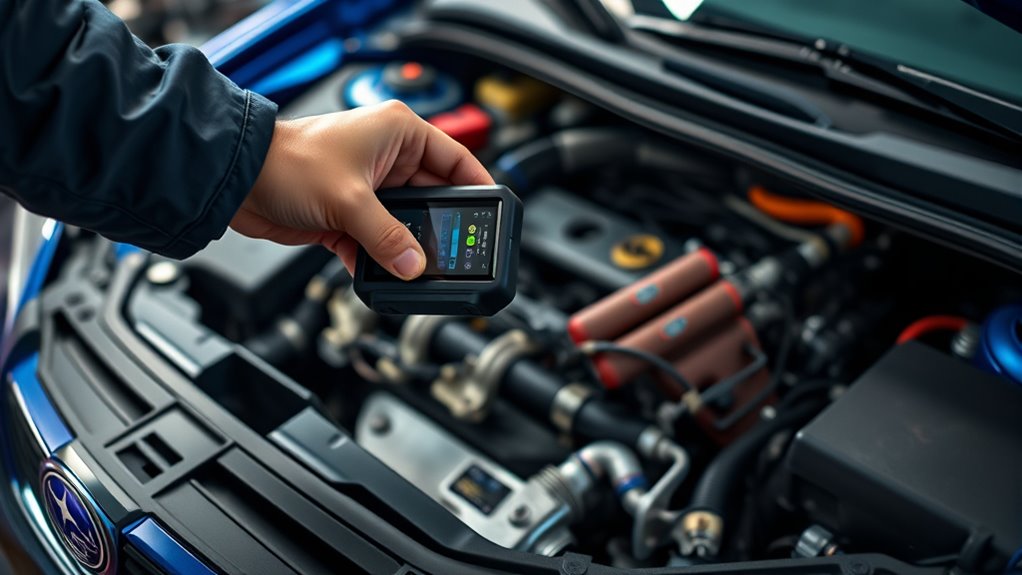
ECU flashing is the process of rewriting the factory-installed software in your Subaru Impreza or WRX’s ECU to change how the engine performs. It’s also called remapping or flash tuning, and it involves altering key engine parameters like fuel maps, ignition timing, and boost pressure. You perform this via the OBD-II port using specialized cables and software, which interface with your vehicle’s ECU. The process keeps the original hardware intact but updates the calibration, just like factory engineers do. The ECU software contains maps that control air-fuel ratios and ignition timing, while sensors like wideband O2 sensors and knock sensors provide real-time data. This allows you to unlock hidden performance, improve throttle response, and tailor the engine’s behavior to aftermarket parts—all while maintaining safety and reversibility. Additionally, understanding the impact of performance tuning on engine behavior can help you optimize your vehicle’s capabilities safely. Modern ECU flashing can also incorporate AI-powered security measures to prevent unauthorized modifications and ensure system integrity. Many modern vehicles also use security protocols to protect against unauthorized ECU modifications, ensuring your tuning remains safe and effective. Recognizing the importance of factory calibration can help you make informed decisions when customizing your vehicle’s performance.
Compatible Subaru Models and Engine Types

If you’re considering ECU flashing for your Subaru, it’s important to know which models and engine types are compatible. For pre-2005 models, like early Impreza RS/WRX (GC/GF chassis), Legacy, Outback with EJ25D or EJ251 engines, and Forester SF5 with EJ205/EJ255 turbo engines, compatibility exists but with limited XML definitions. Between 2005-2014, turbo models such as Impreza WRX/STI (GD/GR), Legacy GT, Outback XT, and Forester XT are fully supported, mainly using DENSO ECUs like SH-7058/59. From 2015 onwards, non-DIT models including certain Impreza, Forester, and WRX variants with SH-7247 processors are compatible, though some 2018+ models might have CANbus encryption. DIT models (2015+ WRX/STI, Ascent, BRZ, Forester FB25DIT) generally require specialized tools and aren’t supported natively. Additionally, understanding the ECU architecture can help determine the best approach for tuning and flashing, especially when considering the software protocols used by different ECUs. Recognizing the compatibility of various Subaru models with ECU tuning options can save time and resources during the modification process. It’s also beneficial to consider bees and honey production practices for maintaining healthy colonies, which can indirectly influence vehicle accessories like ECU systems in farm environments.
Essential Hardware and Software Tools
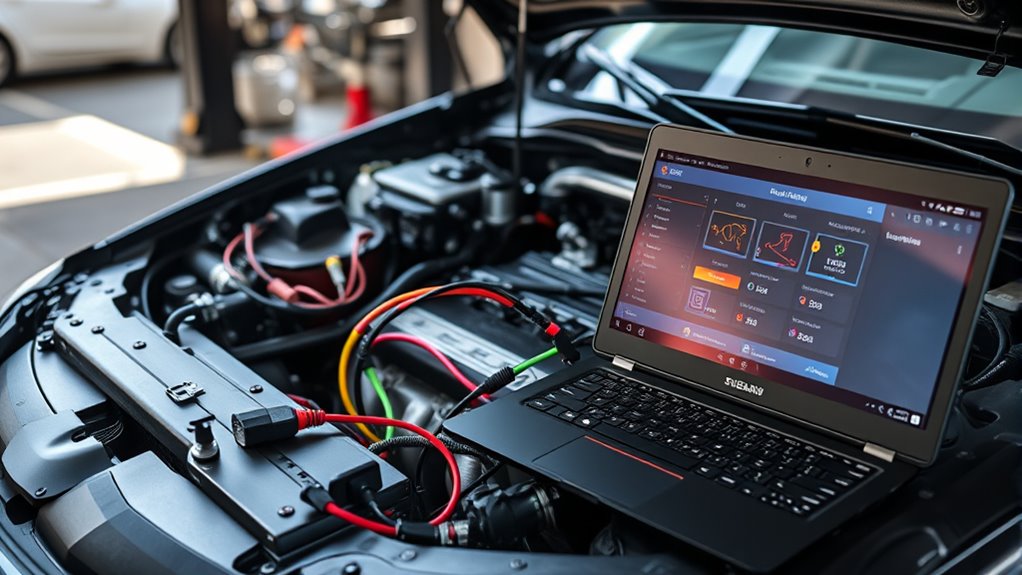
To successfully flash your Subaru’s ECU, you’ll need a combination of reliable hardware and software tools designed for compatibility and safety. First, make certain you have a compatible interface like the Tactrix OpenPort 2.0, which reads and writes ECU data across most Subaru models. Second, choose software such as ECUFlash or RomRaider for editing and flashing maps. Third, connect your setup with vehicle-specific connectors or jumper bypasses, depending on your model. Fourth, use a stable laptop or PC to run the software, log data, and manage maps. These tools are essential for safe, effective ECU tuning, ensuring your modifications are precise and reliable. Proper hardware and software setup forms the foundation for successful Subaru ECU flashing, especially when considering compatibility with your vehicle. Additionally, ensuring that your hardware is vetted and up-to-date minimizes the risk of errors or damage during the flashing process. It is also beneficial to familiarize yourself with ECU security features, which can prevent unauthorized modifications and protect your vehicle’s electronic systems. Understanding ECU firmware can help prevent issues related to incompatible updates or corrupt files during flashing, and staying informed about software updates can improve overall flashing success.
Preparing Your Vehicle for ECU Tuning
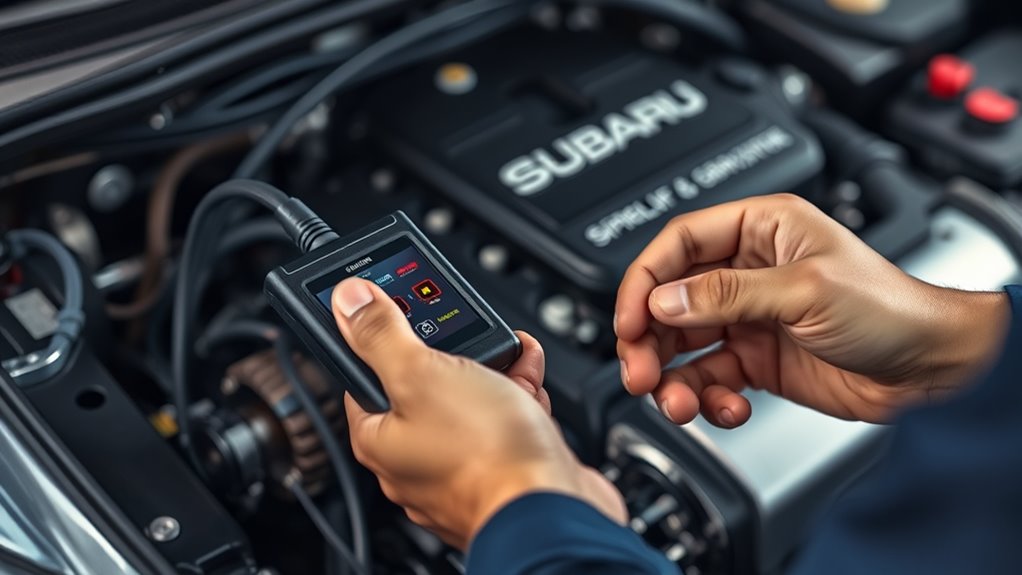
Preparing your vehicle for ECU tuning is a critical step that guarantees your modifications will be safe and effective. Begin by performing compression tests to ensure cylinders are within specifications and leakdown tests to confirm engine integrity, with leakage under 7%. Check oil and coolant levels, topping off if needed, and inspect the cylinder head and valves for wear or damage. Verify the fuel system is leak-free, using the correct fuel type and ensuring injectors are clean and functioning properly. Inspect the exhaust system for leaks, blockages, or damage, and consider upgrading for better performance. Confirm the radiator, intercooler, and other cooling components are in good condition. Additionally, inspecting the combustion process can help identify potential issues that might affect tuning outcomes. Ensuring proper system efficiency can prevent performance issues after flashing. Monitoring engine parameters with data logging software can help detect irregularities early and ensure the vehicle is ready for safe and precise ECU flashing. Regular checks on vehicle sensors also contribute to optimal tuning results and engine longevity. Furthermore, assessing sensor calibration ensures accurate readings essential for safe engine management.
Step-by-Step Guide to Flashing Your ECU
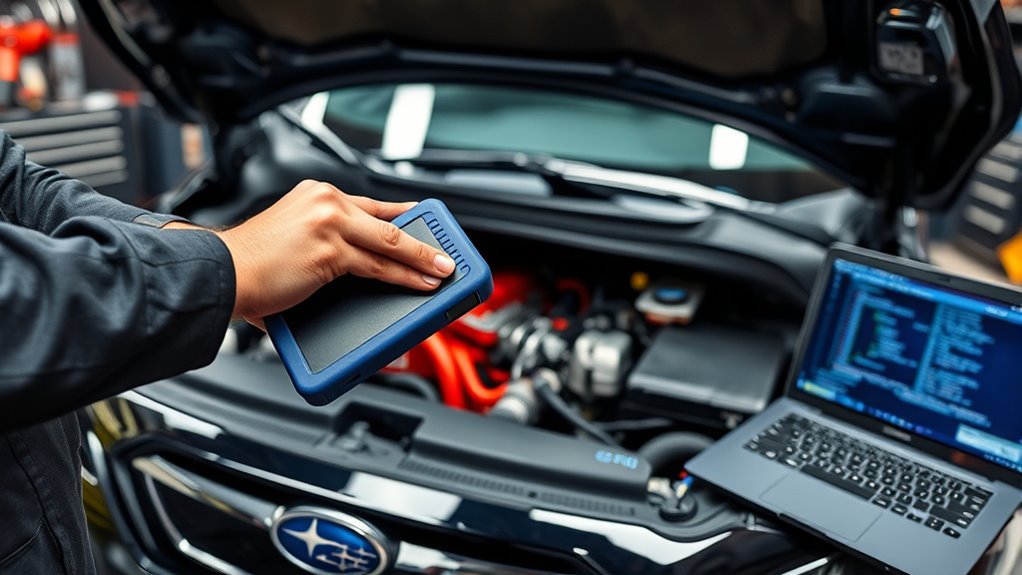
Flashing your ECU involves a precise process that starts with setting up the right tools and environment. First, you need to:
- Select the appropriate software like EcuFlash or Romraider.
- Connect your laptop securely to the vehicle’s ECU.
- Identify and use the correct flash connector, especially for models like the 04+ WRX.
- Provide 12V power to the ECU by jumping the flash connector, then back up the original ECU image.
- Ensure you are familiar with the Vetted – Halloween Product Reviews to understand the importance of quality components during the flashing process. Additionally, understanding the asset division process can help you prepare for any future vehicle-related legal or financial considerations.
Next, install the software, familiarize yourself with ECU pinouts, prepare the flash cables, and identify the correct COM port. Reading the current ECU data and verifying the connection integrity is crucial for a successful flash. Make sure to consult the diagnostic tools documentation to understand how to troubleshoot potential issues during the process. Then, make necessary map edits, save your changes, and validate them. When ready, place the vehicle in flash mode, start the process, monitor progress, and confirm success before restarting the vehicle. Remember that comprehensive knowledge of system security principles can help ensure a safe and successful flashing experience. It is also beneficial to review Glycolic Acid benefits for skin health, as proper maintenance and attention to detail are key in both skin care and vehicle tuning.
Safety Measures and Precautions During Flashing
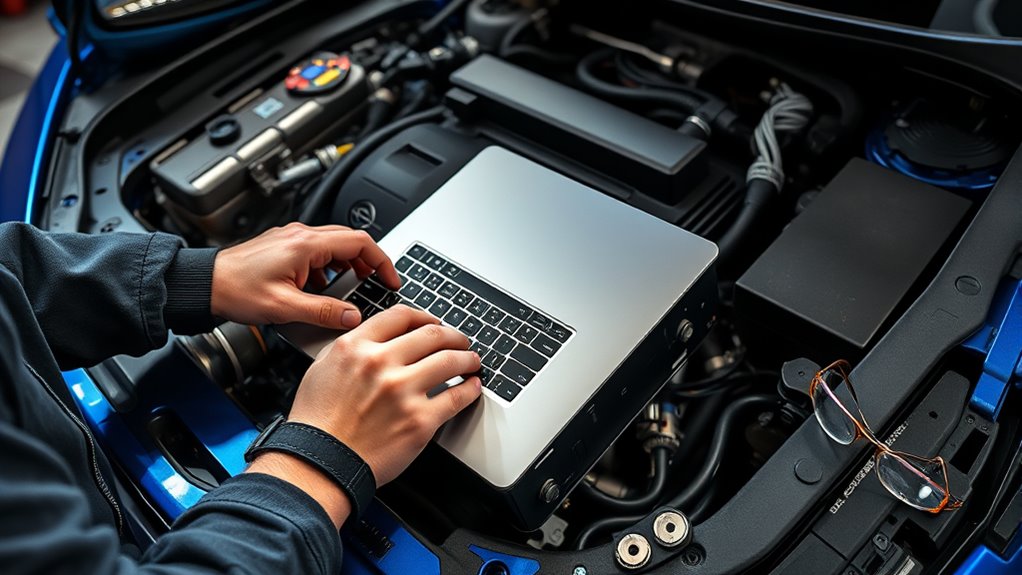
Ensuring safety during ECU flashing is crucial to prevent damage to your vehicle and avoid costly mistakes. You must maintain a stable power supply by ensuring the battery is fully charged or using a charger. Disconnect any CAN-Bus devices like alarms to prevent interference. Never turn off the vehicle or disconnect cables during flashing, as this risks bricking the ECU. Clear error messages beforehand and back up your ECU’s original software. Use a stable environment, free from electrical disturbances. Seek professional help if unsure. Here’s a quick overview:
| Step | Action | Importance |
|---|---|---|
| Battery Check | Fully charge or charge during flashing | Prevents power loss |
| Disconnect CAN-Bus Devices | Remove alarm/system interference | Avoid signal conflicts |
| Maintain Power | Don’t turn off vehicle or disconnect | Prevents ECU damage |
| Clear Errors | Resolve error messages beforehand | Ensures smooth flashing |
| Backup Files | Save original ECU software | Enables recovery if needed |
Additionally, understanding electrical disturbances can help in creating a safe environment for flashing.
Optimizing Performance With Custom Maps
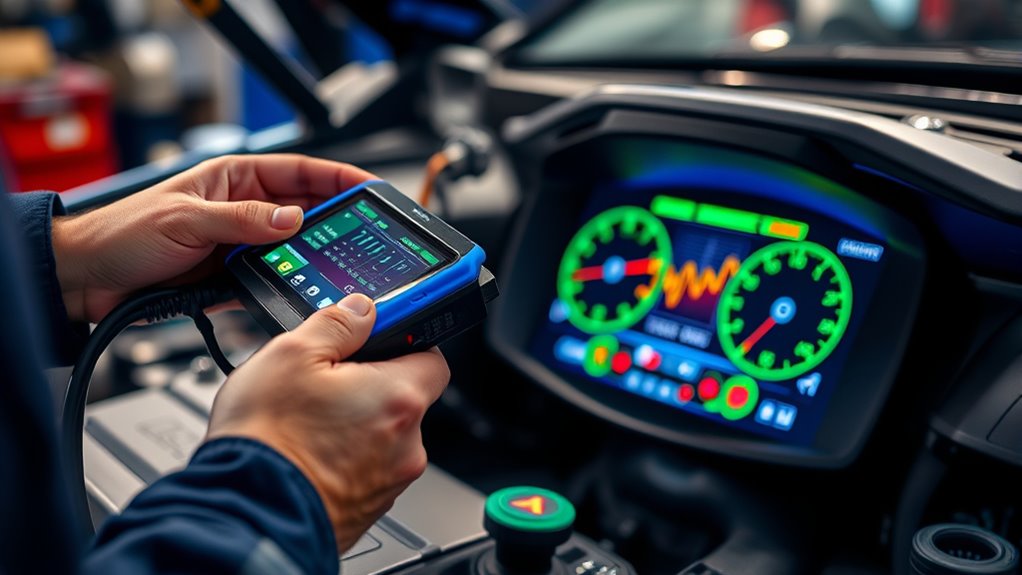
Custom maps are a powerful tool to enhance your Subaru’s performance by fine-tuning engine parameters for specific driving conditions. With a custom map, you can release extra power and improve overall drivability. Here’s what you can achieve:
- Increase power output by around 10-20 horsepower at the wheels.
- Optimize boost targeting for consistent performance across different terrains.
- Improve throttle response for smoother acceleration.
- Reduce false knock issues, helping protect your engine.
These benefits are possible because custom maps are tailored to your vehicle’s setup and fuel type, whether 91, 93, or ACN91 octane. Using tuning tools like EcuFlash, Romraider, or Cobb Accessport, you can load these maps easily, ensuring your Subaru performs at its best under various conditions.
Troubleshooting Common Flashing Issues
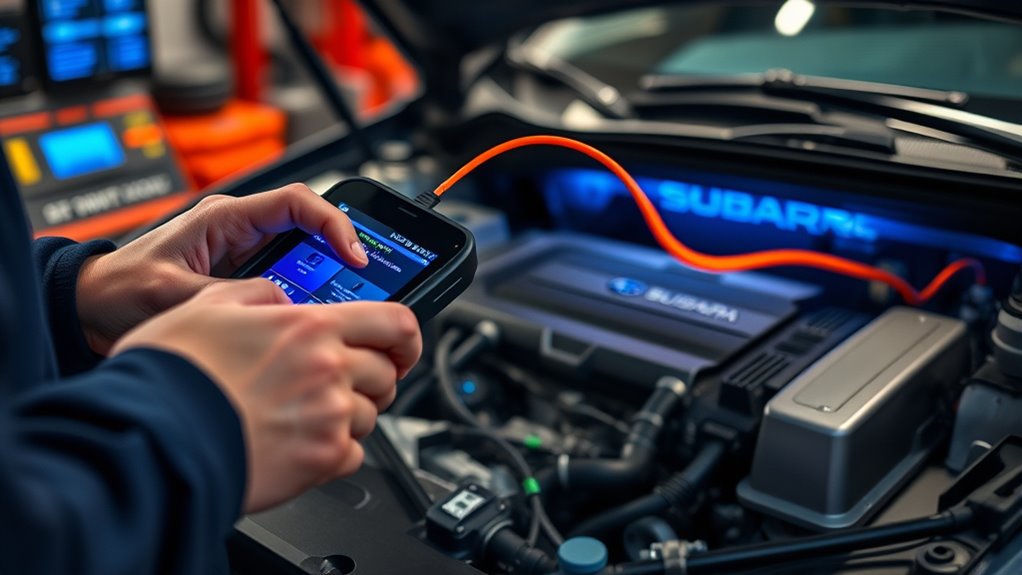
Even with well-prepared maps and proper tools, flashing your Subaru’s ECU can run into problems. Communication issues often stem from driver problems, like outdated USB drivers for your Tactrix cable, which can block data transfer. After ECU replacement or swapping, you might need to re-flash or reset the ECU to restore communication. Faulty or corroded OBD-II connectors and pins also hinder connection, causing flashing failures. Software incompatibilities or outdated tools can lead to errors, so verify you’re using the latest versions recommended for your model. Loose or improperly engaged ECU connectors prevent successful flashing, and flaky power sources, such as old batteries or unstable voltage, cause errors. Regularly inspect cables, connectors, and power supplies to avoid these common issues.
Enhancing Your Subaru’s Performance Post-Flash

After flashing your Subaru’s ECU, you’ll notice immediate performance improvements, but further tuning can unseal even more potential. To maximize your car’s capabilities, consider these enhancements:
- Fine-tune fuel and ignition maps to boost throttle response, torque, and power across RPM ranges.
- Optimize boost control and turbo maps to reduce lag and improve acceleration.
- Enable advanced features like launch control or speed-density fueling for better drivability and performance.
- Recalibrate transmission and driveability settings, ensuring smoother shifts and more predictable throttle feel.
These adjustments improve engine efficiency, responsiveness, and power delivery, transforming your Subaru into a more dynamic, enjoyable ride. With targeted tuning, you’ll unlock the full potential of your vehicle’s upgraded ECU.
Frequently Asked Questions
Can I Revert to Stock ECU Settings After Flashing?
Yes, you can revert to stock ECU settings after flashing. First, use the “Uninstall” option on your Accessport to restore the stock map and unmarry the device. Alternatively, if you’re using open-source tools like ECUFlash, you’ll need to flash the original stock ROM you saved beforehand. Dealer reflash is also an option—they can reset your ECU to factory settings using their specialized software. Just guarantee you have the correct stock files and tools.
Is ECU Flashing Legal for Street Use in My Area?
You wonder if ECU flashing is legal for street use in your area. You need to check local and state laws because regulations vary widely. Federal rules prohibit emissions-related modifications that aren’t compliant, and some states enforce stricter bans. Be aware that authorities may scrutinize vehicles with modified ECUs during inspections and could impose fines or penalties. To stay compliant, consider using CARB-certified tunes and keep documentation, ensuring your modifications meet local legal standards.
How Often Should I Update My ECU Software?
Think of your car’s ECU as its brain — it needs fresh ideas to stay sharp. You should update your ECU software regularly, like seasonally or during scheduled maintenance, to keep performance ideal and ensure safety and compliance. Typically, OEM updates arrive quarterly, but stay vigilant for recalls or modifications. Ignoring these updates risks reduced efficiency, safety issues, and potential legal trouble, so make ECU updates a routine part of your vehicle care.
Can ECU Flashing Void My Subaru’s Warranty?
You wonder if ECU flashing can void your Subaru’s warranty. The answer depends on your dealer and region, but generally, modifying the ECU might void parts of your warranty, especially related to engine or emissions systems. Subaru can inspect data logs to detect modifications. While some warranty issues could be denied, manufacturers may still offer goodwill repairs. Always weigh the performance benefits against potential warranty risks before proceeding.
What Are the Signs of a Failed ECU Flash?
So, you think a failed ECU flash is just a minor glitch? Think again. Signs include your check engine light staying on permanently, rough idling, or sudden power surges—like your car’s throwing a tantrum. You might also notice difficulty starting or stalling unexpectedly. If your vehicle’s communication with diagnostic tools is broken or error messages pop up, it’s a dead giveaway that your ECU flash didn’t go as planned.
Conclusion
Now that you’re equipped with the knowledge to flash your Subaru’s ECU, remember—this isn’t just a tweak, it’s a transformation. With careful preparation and precise steps, you’ll unlock your car’s true potential. Embrace the journey, stay vigilant, and enjoy the thrill of a more powerful, responsive ride. Because in the end, it’s not just about flashing the ECU, it’s about unleashing the beast within your Subaru.






